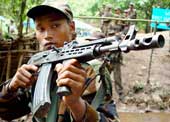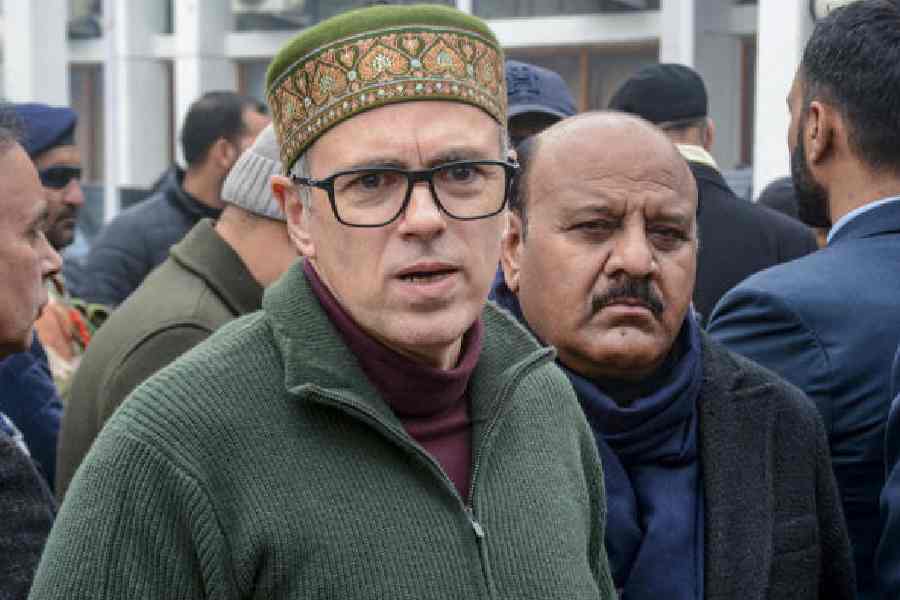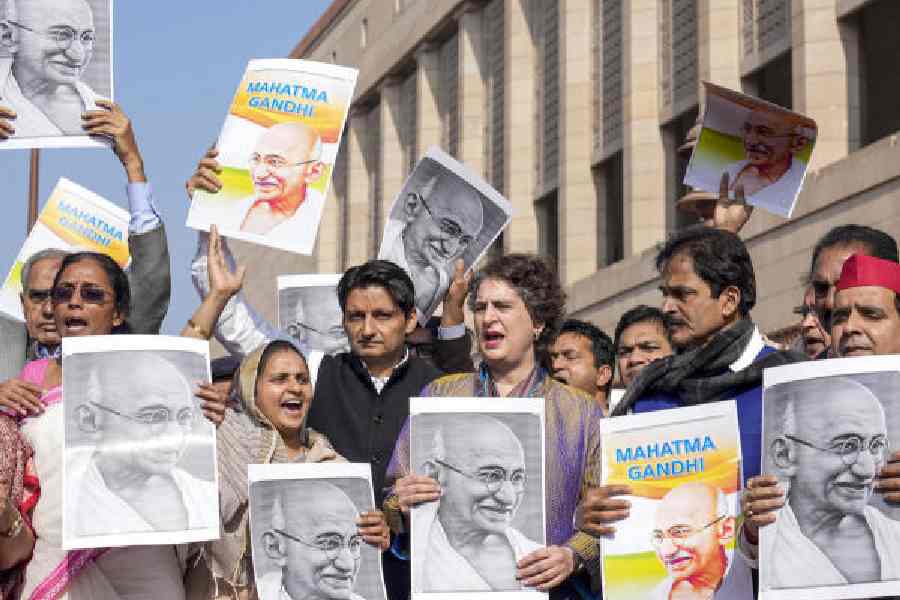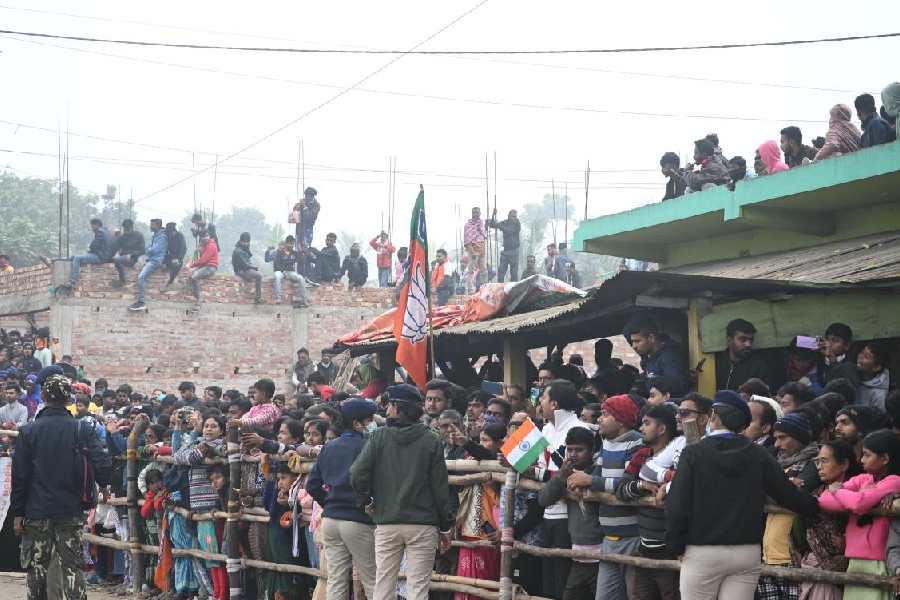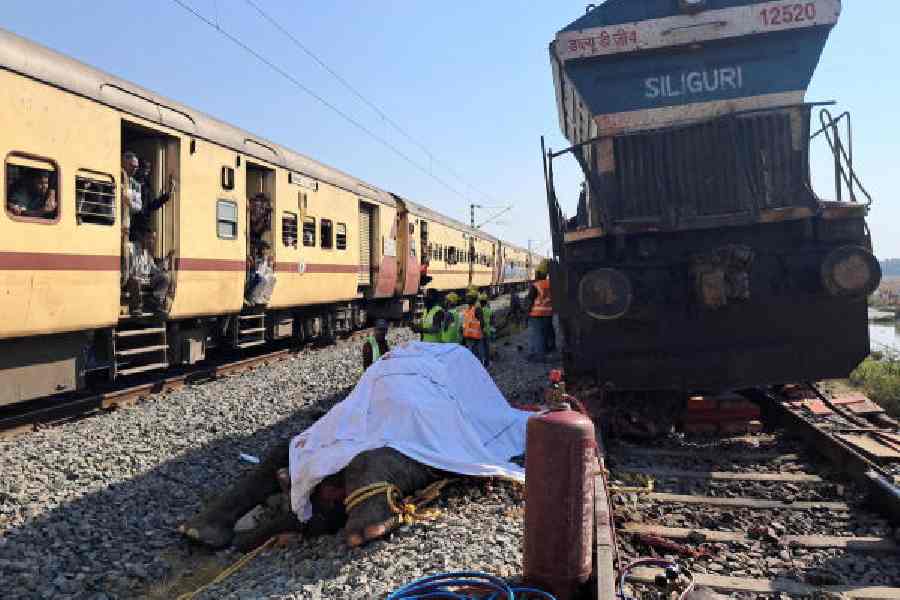 |
| A Northeast militant pointing his gun |
The Northeast firebrand poets write the poetry of emotion and feeling without living in the ivory tower of their fancies, says Rajlakshmi Bhattacharyya
They chose to be a chronicler of their social reality and write the poetry of guns and insurgency. In a world bespattered with blood, suspicion, incessant bickering, scars, burning land, confusion and feuding ways, they wage a silent protest through the might of their pens. Caught at the crossroads of conflicts — both ethnic and militant — they are the key witnesses of a turbulent history.
The Northeast firebrand poets write the poetry of emotion and feeling without living in the ivory tower of their fancies. They mirror the truth unhesitatingly, even when death looks them in the face. But then as Robin Ngangom, poet and lecturer of North East Hill University (Nehu), clarifies, “It would be a mistake to typecast a poet since he is known to change with the times.” In the eyes of Robin, they are “a dodgy lot”, who are hell-bent on capturing their subjective reality.
Robin’s own evolution as a poet began in his teens when he wrote about the gentle hills and folk traditions of yore. But the poet dismisses such romanticism as “artless and inoffensive without shocking any sensibilities”. Over the years, Robin found it increasingly difficult to shut his eyes to “the brutal life” around him. Today, when his friends ask him to write romantic poetry, the words of Pablo Neruda, the Latin American poet, keeps ringing in his ears: “Come and see the blood in the streets,” he quotes with evident ardour.
A Manipuri by descent, Robin feels that contemporary Manipuri poetry has a preponderance of bullets. “The young poets talk of blood, bullets and flowers all in the same breath,” he explains. With violence an all-pervasive influence in their lives, red remains a favourite colour with the new generation of writers. When life for the Manipuri poet gets too oppressive, he takes refuge in self-directed irony, satire and parody. What emerges is a brand of black humour to portray, what Robin calls, “an absurd picture”. But it is not as if all poets talk of violence. Some of them tend to explore myths and their own mindscapes.
Robin’s recent forays into poetry have all the ingredients of a strife-torn world. He talks about “...the trucks carrying the appliances of death and devastation, …the graves of youth who died in confusion…” in The Strange Affair of Robin S. Ngangom. Readers have lapped up such works since they reflect the terror of the times.
In many instances, poetry fraught with tensions and conflicts have, as it were, a cathartic value. While militancy has thrown up a rich harvest of creativity, some amount of artistic freedom is a necessary precondition for its evolution and flowering. Many poets may not join demonstrations and marches but they often write the poetry of subversion. “A writer cannot be a conformist but a natural dissident. And even as poetry cannot bring about a moral revolution, it has the power to heal in stressful eras,” says Robin.
Kynpham Sing Nongkynrih, Robin’s co-editor of Anthology of Contemporary Poetry from the Northeast couldn’t agree more. He feels that Northeast poetry is unique in that the poets speak about real people and real life incidents without intellectualising their experiences unlike the mainland poets. Kynpham opines that living with the menace of the guns, the Northeast poet cannot merely indulge in verbal wizardry and woolly aesthetics but must perforce master the art of witness. “We think the task that literature of the Northeast must address is contained in Alexander Solzhenitsyn’s declaration when he said, ‘Literature that is not the breath of contemporary society that does not warn in time against threatening moral and social dangers — such literature does not deserve the name of literature; it is only a façade.”
Kynpham’s poetry of guns — as opposed to Robin’s direct approach to militancy — is ambivalent. His core concerns range from the outsiders’ influx into Meghalaya to the victimisation of innocents and fellow compatriots in the border states. The poet is a strong advocate of his race, religion and ethnic identity. In The House of Death he tries to voice the mass feelings of the tribals and their outlook towards militants and militancy. Likewise, in Forebodings he writes about the loss of freedom when fear “like a militant/had silenced every sound/ and the timid afternoon/was slinking out like peace/from this town”. He records the restless unease of each day in the Diary of a Newsman when pages are filled “with murders and shootouts/which have also become mundane….”
Packed with strength, power, sadness and lyricism, Northeast poetry explores the many-layered complexities in human relationships. It involves not just the dynamics of a man-woman relationship but the kinship between man and man and woman and woman, who are faced with the same dilemmas and predicaments. According to poet Ananya Shankar Guha, regional director of Indira Gandhi National Open University, Northeast poetry often boils down to brotherhood of man where love for fellow beings is paramount. “One group of Tripuri poets may write in Bengali, while another section writes in the native Kokborok, but there is no essential difference in their thoughts and expressions.”
Guha believes that Northeast poetry resonates with lyricism that is rooted in the tribal’s natural instinct for music. “Apart from a deep-seated conflict between ‘what is’ and ‘what could have been’ — the hiatus between the past and present — there is also a recurrence of violence as a kind of leitmotif. This is true especially of the young generation of Assamese and Manipuri poets who are known to be reactionary in spirit. The ‘ethnic poets’ have a shared nostalgia for the past and write about the prevalent social issues with their attendant pitfalls,” avers Guha.
Paul Lyngdoh, a poet and minister for sports and youth affairs, has a similar take on the subject. As he elaborates, “Northeast poetry is reflective of the dilemmas of a society in transition. The tribal ancestry of the past and the developments of the present create a conflict in the poet’s mind. Add to that an ever-present gun culture and what we have here is poetry written in blood. While mainland India might dismiss insurgency as just another law and order problem, in the Northeast it is a life and death situation.” His poetry as in To Whom It May Concern often makes oblique references to militancy, which “has been fuelled by the ignorance of mainland India”.
Perhaps, the most evocative pieces have emerged from the writings of Manipuri and Tripuri poets, since they portray the pain of affected societies more intensely. There is a constant reference to the destruction of civilisation and all that was beautiful in their world. Such outpourings are but inevitable, for as poet and folklorist Desmond Kharmawphlang says, “Poets cannot be oblivious to what is happening around them. Some of them have made tangential references to the problem of militancy while others have played it down.” His own poems have made a few passing remarks to insurgency and volatile situations, which have been the outcome of ethnic misunderstandings.
Repercussions of this sort can best be allayed through the medium of poetry. And this brings us back to the point where Northeast poetry is considered a balm to frayed nerves. Poet Piyush Dhar, editor of Pahariya, a Bengali poetry magazine, explains, “Since the mid-eighties when killings and political turmoil were at their peak, the Northeast poets wrote the poetry of protest.” Dhar, who has organised two Northeast poetry festivals, is a firm believer of using creativity to initiate the peace process. “Open rhetoric can never be a means to solve ethnic conflicts,” he says.
His experience has shown that people — whether tribals or minorities — face the same problems. “Prolonged unrest in the Northeast has led to everyone being economically deprived. In such a scenario, all poets write with the same angst and frustration. It’s time we were united in our thoughts and words.”
If poetry has its origins in the aspirations and daily chores of the people, the Northeast has spawned a culture where guns and roses coexist side by side. An offshoot of the pain and the terror that has besieged the region, Northeast poetry comes straight from the heart.

